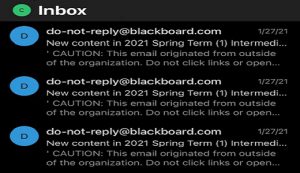Use of Blackboard Learn skyrocketed by 400% from pre-pandemic 2019 to 2020 worldwide, according to the company blog. However, the confusing menu layouts and frequent bugs which define the Blackboard experience are only adding to the frustrations of virtual learning for the Hunter community.
For students, Blackboard’s layout can lead to missed assignments and dizzying tab-switching to find vital information for classes.
“I am relying on Blackboard a lot more,” said Casey Goldstein, a senior undergraduate student at Hunter College, “I am worried that I will miss an assignment or something that is tucked away in a remote tab.”
Goldstein worked with Blackboard since the start of his college career at Central Piedmont Community College in Charlotte, North Carolina. Even then, the site’s frequent crashes and irritating notification system made Blackboard difficult to use.
“Sometimes Blackboard sends a thousand notifications if a professor is uploading documents,” said Goldstein. “Among all the notifications, it’s hard to know what is important.”
Goldstein wishes Hunter would switch to a system with a faster and cleaner interface and better communication with teachers to improve his online learning experience.
“Blackboard has frequent crashes and doesn’t reliably work on mobile devices,” said Goldstein. “Having more detailed syllabuses and more reliable reminders from teachers could help with online learning.”
As virtual learning dominates, Hunter students and professors struggle to maintain the classroom experience with Blackboard’s issues in the way. CUNY did not respond when asked to comment on faculty and student criticism of Blackboard.
For professor Anne Graziano, an English department adjunct at Hunter College, online teaching means more work that does not always pay off. Graziano notes the alienation many students feel learning in a virtual classroom.
“I have had to call in when my audio has not worked properly,” said Graziano about Blackboard Collaborate. “So, there are occasional glitches. Students also are not always happy about the sound quality.”
Mowmita Jabir, an administrative coordinator and trainer at the Technology Resource Center at Hunter College, says the Blackboard-uninitiated faculty struggle to learn the system.
“Professors are unique in the ways they teach, and they expect certain things when they are teaching. Sometimes they need to modify their teaching since what they are trying to accomplish, they can’t do using Blackboard,” said Jabir. “But they are accepting of that and they also incorporate other tools in Blackboard in order to accomplish that. The biggest strength of Blackboard is that it makes communication with students easier which is a big part of teaching remotely.”
Jabir says the grade center is one of the most challenging parts of Blackboard for professors to grasp.
The inability to retain certain settings or set up instructor’s choices as default ranks among many of Blackboard’s limitations.
According to Student Career Programs Manager Keith Okrosy, difficult navigation and outdated interface hinder Blackboard’s full potential.
“For instance, for a presentation assignment I wanted to create a simple sign-up sheet, which in person would be a simple thing to accomplish,” said Okrosy. “However, using Blackboard I first had to query my colleagues for suggestions on creating such a tool and the steps to doing so were numerous. It’s a powerful tool, but can be cumbersome.”
In addition to his role as technology coordinator, Okrosy teaches as an adjunct at other local colleges. Proficiency in Blackboard, and its many various modules like discussion boards, assessments and Blackboard Collaborate proved necessary in Okrosy’s teaching experience.
Okrosy had better luck with Canvas, another online learning platform. As an adjunct, Canvas allowed Okrosy to streamline task completion and save time.
Despite Blackboard’s shortcomings, Okrosy emphasizes the value of proficiency in versatile software platforms, Blackboard included, for students entering the workforce.
Blackboard, Zoom, Flipgrid, Instructure Canvas and Slack rank among the technology skills relevant to remote work environments, according to new data from the Bureau of Labor Statistics.
“While many companies may not use Blackboard specifically, many software platforms are similar in how they operate,” said Okrosy. “Having people who are skilled in using multiple platforms and that can easily navigate software systems can be an asset.”
Proficiency in digital technology is among the top ten most sought-after cognitive competencies in the workforce, according to a report from the Georgetown University Center on Education and the Workforce. Almost 60% of workers with a minimum education of a bachelor’s degree cited proficiency with digital technology as one of the crucial competencies most important in their place of work.


